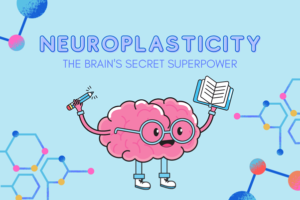The human brain is an astonishing organ capable of reshaping itself in response to various stimuli, a phenomenon known as neuroplasticity. Neuroplasticity, often referred to as the brain’s plastic nature, is the remarkable ability to reorganize itself by forming new neural connections throughout life. This process involves the strengthening of existing neural pathways and the creation of new synapses, ultimately shaping the brain’s structure and function. Neuroplasticity is a cornerstone of learning, memory, and cognitive flexibility.
Not only will harnessing neuroplasticity help improve strength, power, and balance inside the gym, it can help you outside the gym as well whether that be to help you maintain independence or perform your best on the sporting field. We have a proteome known as BDNF (brain-derived neurotrophic factor) to thank for this. This protein is responsible for promoting the growth, survival, and differentiation of neural pathways.
Exercise has been shown to increase levels of BDNF found within the body. While resistance exercise can increase these levels, it has been shown that aerobic exercise has the most impact on increasing BDNF levels. It has been shown that aerobic exercise on at least three days per week, for at least 30 minutes at 70% of your estimated heart rate maximum will optimally increase BDNF. Doing this prior to learning new skills or working on challenging movements gives us the best opportunity strengthen existing neural pathways or creating new ones.
So, who does this apply to:
- Newbie gains
Newbie gains is the name given to the rapid increase in strength that someone who is new to a particular type of exercise may experience. This is largely due to neuroplasticity and the body simply becoming more efficient and simply better overall at what you are asking it to do. For example, say you want to learn how to do a bench press. The first few weeks may feel a little wobbly but as your body creates new pathways for learning the movement, within the first 6 weeks your central nervous system will learn how to perform this more efficiently and this will be reflected in being able to perform the movement smoothly, increase the weight you are using, or increasing the number of repetitions you can perform without necessarily having made the physical adaptations to the muscle generally associated with strength gains.
- Skill acquisition
Skill acquisition, also referred to as motor learning and control, is the interdisciplinary science of intention, perception, action, and calibration of the performer-environment relationship. Neuroplasticity can also help you with skill acquisition to facilitate learning new skills or get better at skills you have already learnt. This may be applied in a sporting context such as learning how to add spin to the ball during bat-ball sports or learning a new skill in gymnastics. It may even be as simple as improving on a seemingly simple skill such as standing up out of a chair, climbing stairs, or performing balance tasks in older populations.
- Neurological disorders
There is also a large body of evidence to support the possibility of neuroplastic changes in those with neurological conditions such as spinal cord injury, brain injuries, dementia, Parkinson’s, or Multiple Sclerosis. Utilizing the power of neuroplasticity is arguably most important in these populations as it can have the most impact on quality of life. Performing aerobic exercise to increase levels of BDNF in the body can help get the most out of goal-based activities such as re-learning how to walk or improving gait, improving fine motor skills, or re-learning how to do skills or hobbies that may have been impacted such as riding a bike all of which can improve independence and quality of life for those impacted by these conditions.




